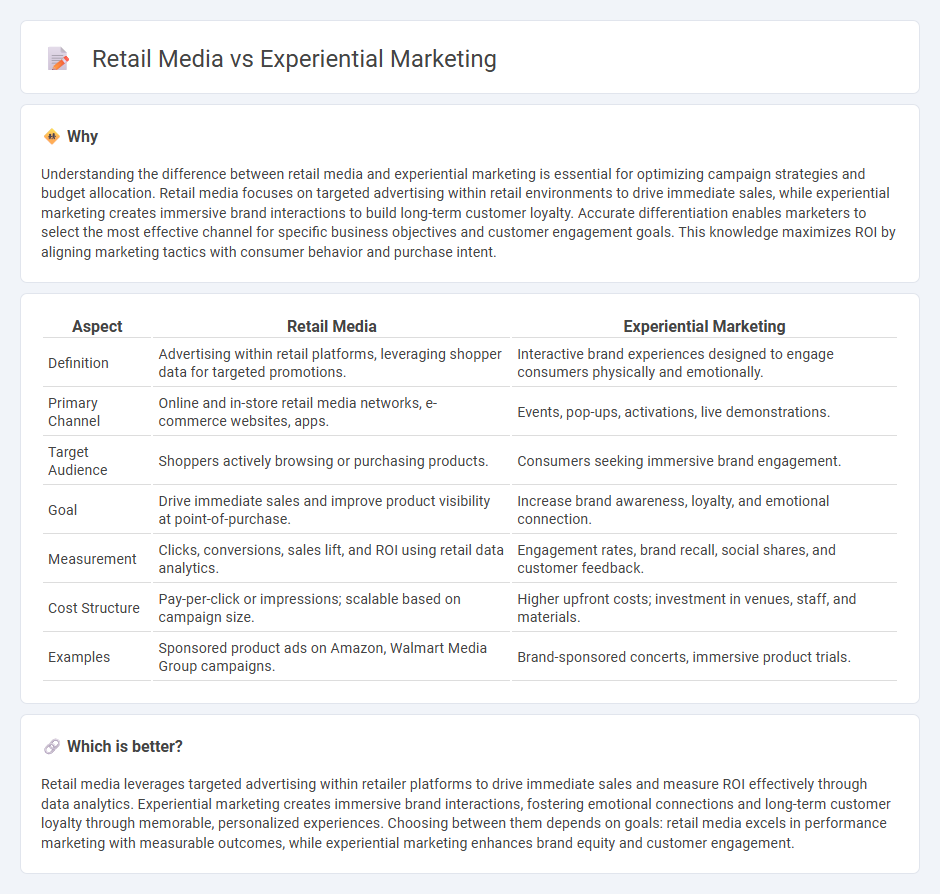
Retail media leverages data-driven advertising within online and physical store environments to directly target shoppers at the point of purchase, boosting sales through personalized promotions and product placements. Experiential marketing creates immersive, memorable brand interactions, fostering deeper emotional connections and lasting customer loyalty by engaging all senses in unique physical or digital experiences. Discover how combining these strategies can amplify your brand's impact and drive consumer engagement.
Why it is important
Understanding the difference between retail media and experiential marketing is essential for optimizing campaign strategies and budget allocation. Retail media focuses on targeted advertising within retail environments to drive immediate sales, while experiential marketing creates immersive brand interactions to build long-term customer loyalty. Accurate differentiation enables marketers to select the most effective channel for specific business objectives and customer engagement goals. This knowledge maximizes ROI by aligning marketing tactics with consumer behavior and purchase intent.
Comparison Table
| Aspect | Retail Media | Experiential Marketing |
|---|---|---|
| Definition | Advertising within retail platforms, leveraging shopper data for targeted promotions. | Interactive brand experiences designed to engage consumers physically and emotionally. |
| Primary Channel | Online and in-store retail media networks, e-commerce websites, apps. | Events, pop-ups, activations, live demonstrations. |
| Target Audience | Shoppers actively browsing or purchasing products. | Consumers seeking immersive brand engagement. |
| Goal | Drive immediate sales and improve product visibility at point-of-purchase. | Increase brand awareness, loyalty, and emotional connection. |
| Measurement | Clicks, conversions, sales lift, and ROI using retail data analytics. | Engagement rates, brand recall, social shares, and customer feedback. |
| Cost Structure | Pay-per-click or impressions; scalable based on campaign size. | Higher upfront costs; investment in venues, staff, and materials. |
| Examples | Sponsored product ads on Amazon, Walmart Media Group campaigns. | Brand-sponsored concerts, immersive product trials. |
Which is better?
Retail media leverages targeted advertising within retailer platforms to drive immediate sales and measure ROI effectively through data analytics. Experiential marketing creates immersive brand interactions, fostering emotional connections and long-term customer loyalty through memorable, personalized experiences. Choosing between them depends on goals: retail media excels in performance marketing with measurable outcomes, while experiential marketing enhances brand equity and customer engagement.
Connection
Retail media leverages data-driven advertising within shopping environments to engage consumers at the point of purchase, while experiential marketing creates immersive brand experiences that deepen emotional connections. Both strategies converge by utilizing real-time consumer insights to personalize interactions and drive higher conversion rates. Integrating retail media with experiential marketing enhances customer engagement through tailored messaging that resonates during in-store and online journeys.
Key Terms
**Experiential Marketing:**
Experiential marketing creates immersive brand experiences that engage consumers through interactive events and sensory stimulation, driving emotional connections and brand loyalty. It leverages real-world touchpoints to foster memorable customer interactions, often resulting in higher brand recall and advocacy compared to traditional advertising. Explore how experiential marketing strategies can transform customer engagement and elevate your brand presence.
Brand Activation
Experiential marketing drives brand activation through immersive, interactive experiences that foster emotional connections and consumer engagement. Retail media leverages targeted digital ads within retail environments to influence purchase decisions and enhance brand visibility at the point of sale. Explore how combining experiential marketing with retail media strategies can amplify brand activation impact.
Immersive Engagement
Experiential marketing leverages immersive brand experiences to create deep emotional connections and lasting consumer impressions through interactive events and sensory engagement. Retail media harnesses targeted advertising within retail environments, utilizing data-driven strategies to influence purchase decisions at the point of sale and enhance shopper personalization. Explore how combining immersive engagement with retail media can transform customer interactions and drive higher conversion rates.
Source and External Links
Engagement marketing - Wikipedia - Experiential marketing is the live, one-on-one interactions that create emotional and sensory engagement, helping brands build customer loyalty through memorable, personalized experiences that differentiate them from competitors.
What is experiential marketing? Definition and examples - Experiential marketing connects consumers with brands via immersive experiences such as pop-ups or virtual events that engage customers in unique and memorable ways beyond traditional advertising.
What is experiential marketing: Definition, why it works & examples - Experiential marketing builds authentic emotional connections by offering tangible, sensory interactions that enhance brand perception, increase engagement, and boost return on investment through memorable customer experiences.
 dowidth.com
dowidth.com